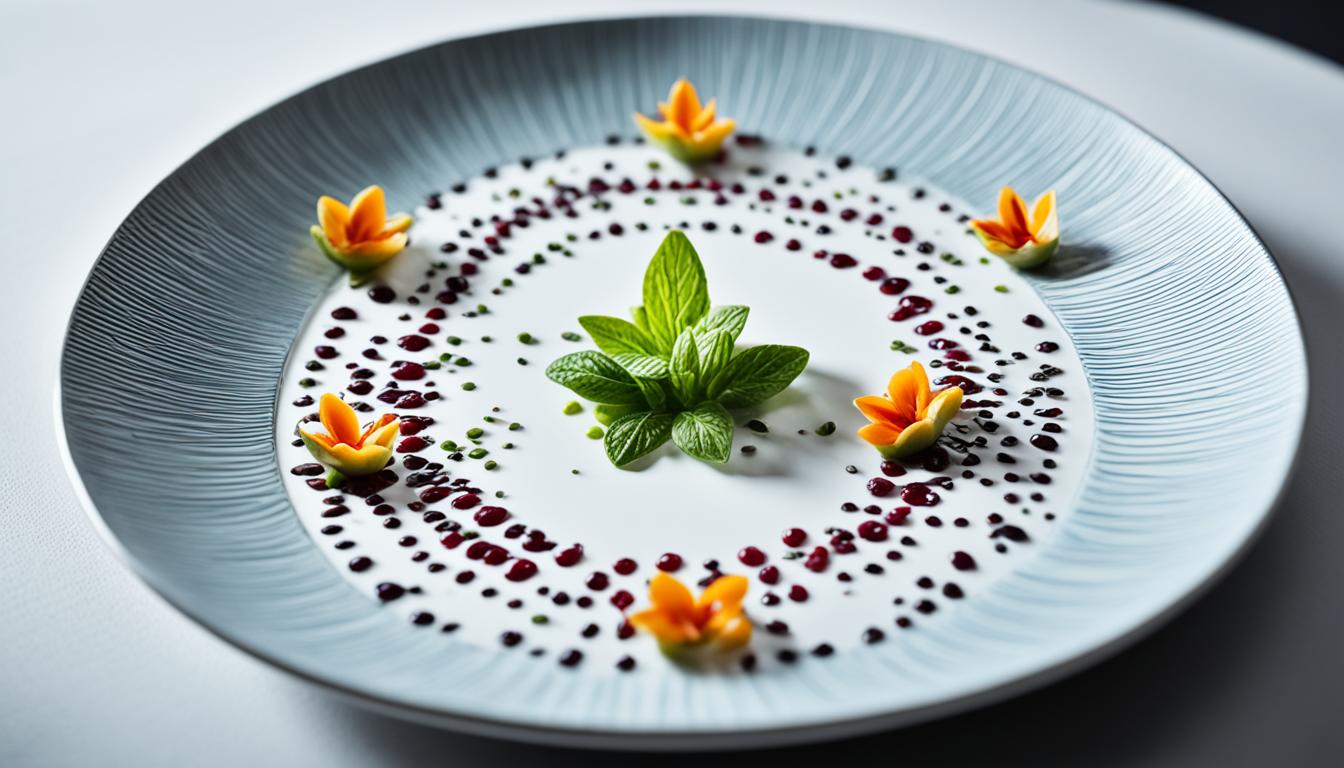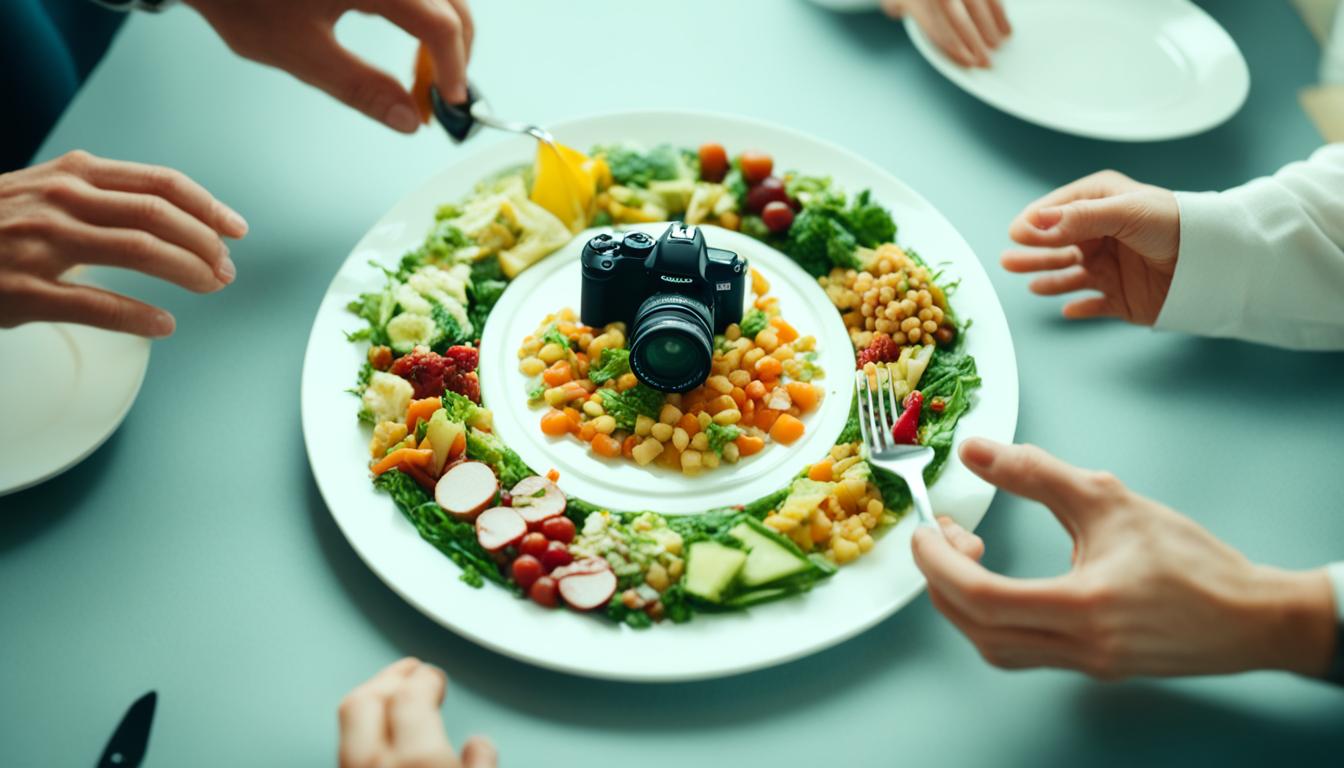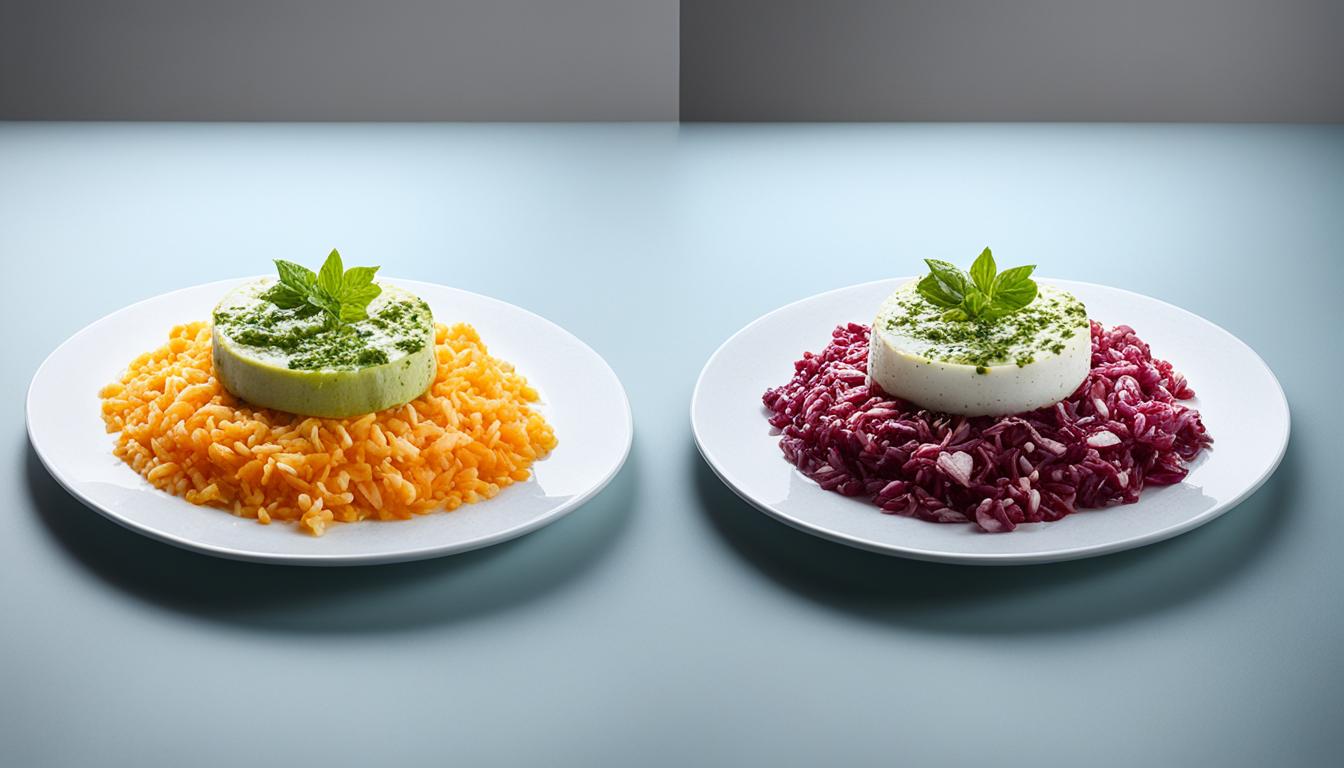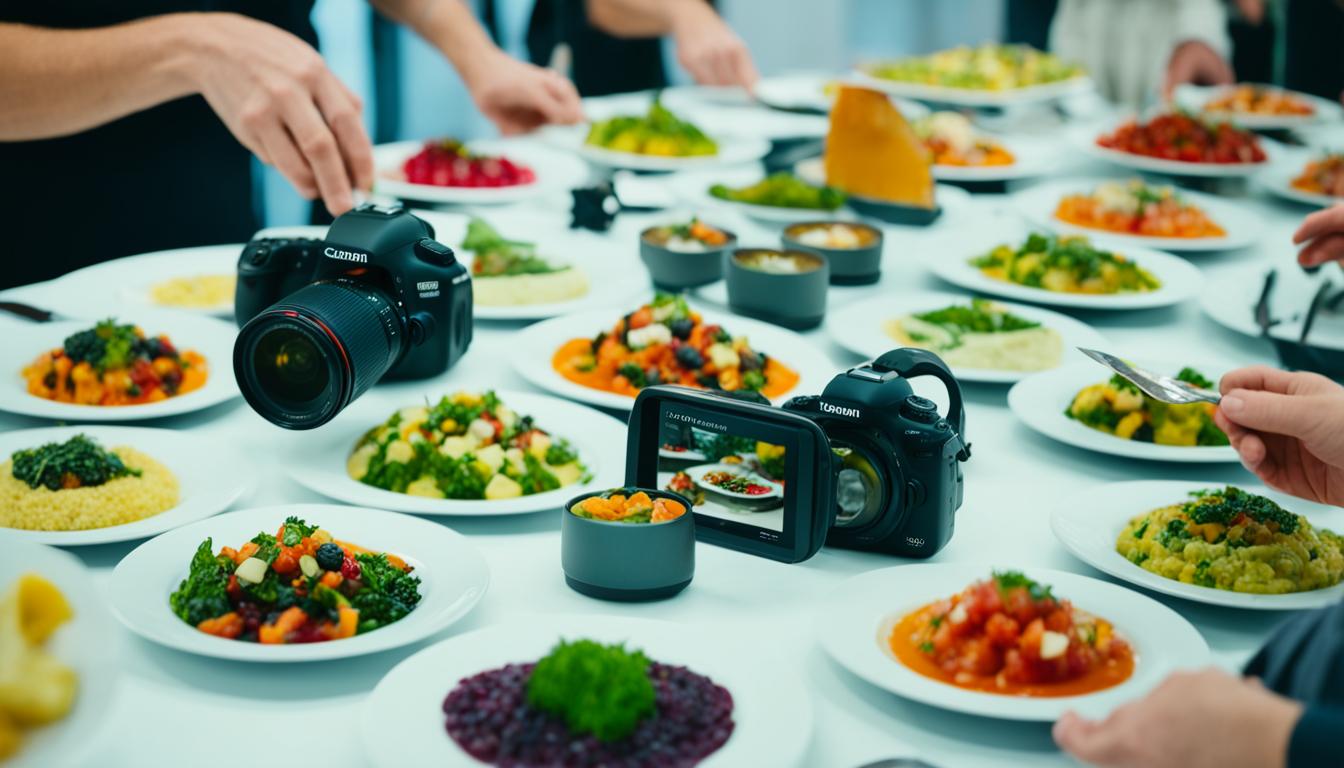When it comes to food photography, there’s more to it than just snapping a quick picture of a delicious dish. To truly capture the essence and beauty of food, you need to master advanced techniques that showcase its flavors, textures, and colors in dynamic and enticing ways. In this article, we’ll explore some professional tips and tricks that can take your food photography to the next level.
Key Takeaways:
- Mastering advanced food photography techniques can help you capture high-quality, dynamic images of food.
- Experiment with motion and action shots to add excitement and energy to your food photos.
- Consider food styling tips and the use of props to enhance the visual appeal of your images.
- Understanding composition techniques like camera angles and depth of field can greatly improve the visual appeal of your food photos.
- Don’t be afraid to get creative and think outside the box to create unique and captivating food images.
Understanding Food Photography Composition
Food photography is a major genre within still life photography that allows us to capture the beauty and uniqueness of food. One of the key elements in creating compelling food photos is composition. By applying various composition techniques, photographers can craft visually appealing and engaging images that tell a story through the arrangement of elements within the frame.
Composition techniques such as the rule of thirds, the golden ratio, dynamic symmetry, the golden triangle, and the golden spiral serve as valuable tools for creating balance, directing the viewer’s gaze, and conveying a narrative through the composition of food and accompanying props. These techniques provide a framework for arranging elements within the frame and help us create visually stunning images that captivate viewers.
For instance, the rule of thirds divides the frame into a 3×3 grid, and placing key elements along these gridlines or at their intersections can create a sense of balance and visual interest. The golden ratio, similar to the rule of thirds, offers a harmonious composition by dividing the frame into aesthetically pleasing proportions. Dynamic symmetry, another technique, involves the careful arrangement of elements to create a visually dynamic and engaging composition.
The golden triangle and golden spiral are compositional theories that guide our eye through the frame in an aesthetically pleasing way. By understanding these theories and applying them to our food photography, we can create captivating images that draw the viewer’s attention and keep them engaged.
The Importance of Planning Compositions
Planning compositions is a crucial step in food photography. Sketching out potential compositions beforehand allows us to visualize how different elements will interact within the frame and experiment with various arrangements. Additionally, utilizing overlays in live view screens can help us align our compositions with the desired composition techniques.
By taking the time to plan our compositions and incorporate a variety of composition techniques, we can elevate our food photography and create images that evoke emotion, tell a story, and leave a lasting impression on viewers.
Storytelling through photography is a powerful way to connect with our audience and convey the beauty and essence of food. Understanding and applying composition techniques in our food photography allows us to create visually pleasing and engaging images that capture the viewer’s attention and evoke a sense of desire and excitement for the cuisine.
Tips for Creative Food Photography
Mastering the art of creative food photography involves a careful consideration of various factors. By focusing on food plating, composition techniques, food styling, backdrop selection, studio lighting, and post-processing, you can create stunning and captivating food images. Let’s explore some essential tips to elevate your food photography game.
1. Food Plating:
Food plating is more than just arranging the food on a plate; it’s about creating visually appealing compositions. Pay attention to colors, textures, and shapes to create visually interesting arrangements. Experiment with different plating techniques, such as stacking, scattering, or layering ingredients, to add depth and dimension to your compositions.
2. Creative Composition:
Composition is the foundation of any great photograph. Experiment with different angles, such as overhead shots or close-ups, to showcase the intricate details of the food. Frame your photos in a way that guides the viewer’s gaze and creates a visually engaging story. Utilize compositional techniques like the rule of thirds or leading lines to create balanced and visually pleasing images.
3. Food Styling and Backdrop:
Food styling and choosing the right backdrop are crucial for creating a cohesive and aesthetically pleasing image. Consider the overall theme or mood you want to convey and select props, surfaces, and backgrounds that complement the food. Use elements like fresh herbs, colorful ingredients, or interesting textures to enhance the visual appeal of the dish.
4. Studio Lighting:
Lighting is essential in food photography as it sets the mood, highlights textures, and adds depth to your images. Experiment with natural light or use artificial lighting setups to achieve the desired effect. Diffuse harsh light sources to create soft, even lighting. Consider using reflectors or diffusers to control the intensity and direction of light.
5. Editing and Post-Processing:
Editing and post-processing can transform a good photo into a great one. Adjust the brightness, contrast, and color balance to enhance the overall appeal of the image. Pay attention to details while sharpening or reducing noise. Use selective editing tools to fine-tune specific areas of the photo. Remember to maintain a natural look while still enhancing the visual impact.

Incorporating these tips into your food photography workflow will help you create visually stunning images that capture the essence and beauty of your dishes. Experiment, explore, and let your creativity shine in every photograph.
Camera Settings for Food Photography
When it comes to food photography, the camera settings you choose can make all the difference. Two key settings to pay attention to are aperture and shutter speed. Let’s dive into how these settings can enhance your food photos.
Aperture
Aperture refers to the opening of the camera lens that determines how much light enters the camera. It is measured in f-stops, with lower values indicating a wider aperture. When shooting food, a wide aperture (a lower f-stop, such as f/2.8 or f/4) can create a shallow depth of field. This means that the foreground of your image will be in sharp focus, while the background will have a soft, blurry effect. This technique is ideal for highlighting the details of a dish and adding an artistic touch to your composition.
Shutter Speed
Shutter speed refers to the length of time the camera’s shutter is open, allowing light to reach the camera sensor. In food photography, choosing the right shutter speed is essential for capturing still or dynamic shots. A slow shutter speed (around 1/30s or slower) can be used to capture still images, ensuring that the food remains sharp and crisp. On the other hand, a fast shutter speed (around 1/250s or faster) is ideal for freezing motion and capturing those captivating action shots of pouring sauces or sprinkling toppings.
Remember, capturing the perfect shot often involves experimenting with different camera settings. Try adjusting the aperture and shutter speed to achieve the desired effect for your food photography.
Tips for Camera Settings:
- Experiment with different aperture settings to achieve the desired depth of field.
- Use a wide aperture for a shallow depth of field and a narrow aperture for greater depth of field.
- Adjust the shutter speed based on the desired effect – slower for still shots, faster for capturing motion.
- Consider using a tripod or image stabilization to avoid camera shake, especially when using slower shutter speeds.
- Review your images on the camera’s LCD screen to assess the exposure and make adjustments if necessary.
By understanding and manipulating camera settings like aperture and shutter speed, you can take your food photography to the next level. Let the camera be your creative tool, capturing the beauty and deliciousness of the dishes you photograph.
| Camera Setting | Effect | Example |
|---|---|---|
| Wide aperture (lower f-stop) | Creates shallow depth of field, focusing on the foreground | |
| Narrow aperture (higher f-stop) | Increases depth of field, ensuring more of the image is in focus | – |
| Slow shutter speed | Blurs motion, ideal for still shots | – |
| Fast shutter speed | Freezes motion, perfect for capturing action shots | – |
Essential Camera Equipment for Food Photography
As passionate food photographers, we understand the importance of having the right camera equipment to capture mouthwatering moments. Whether you’re a beginner or a seasoned pro, investing in quality camera gear can elevate your food photography to new heights. Let us guide you through the essential equipment you need to create stunning images that make taste buds tingle.
Camera: Your Creative Companion
When it comes to cameras, there are various options to suit different preferences and budgets. From full-frame DSLRs to mirrorless cameras, make sure to choose one that allows you to explore your creativity and adjust settings effectively. Familiarize yourself with the manual mode to have complete control over aperture, shutter speed, and ISO.
Lens: Unleash Your Artistic Vision
A good lens is key to capturing the intricate details and textures of food. Consider investing in versatile options that allow for different angles and compositions. Here are some lens recommendations for food photography:
| Lens | Features |
|---|---|
| 50mm prime lens | Ideal for capturing beautiful close-ups and emphasizing food details |
| 24-70mm zoom lens | Offers flexibility in adjusting focal length for a range of compositions |
| Macro lens | Perfect for capturing intricate details, textures, and small subjects |
| 80mm prime lens | Ideal for creating a pleasing depth of field and beautiful bokeh effects |
Tripod: Stability for Perfection
A tripod is an indispensable tool for achieving stability and precision in your food photography. It allows you to capture sharp and focused images while eliminating camera shake. With a tripod, you can take your time to compose the perfect shot, experiment with different angles, and create stunning overhead images.

Filters and Diffusers: Enhancing the Ambiance
To enhance the overall quality of your food photos, consider using filters and diffusers. Filters, such as polarizing filters, can reduce reflections and glare, while neutral density filters help control exposure in bright lighting conditions. Diffusers soften harsh light, creating a more pleasant ambiance and reducing shadows. Experiment with these accessories to add a touch of magic to your food photography.
Now that you have a list of essential camera equipment for food photography, it’s time to equip yourself with the tools that will help you bring food to life through your lens. With the right camera, lens, tripod, and accessories, you’ll be ready to capture tantalizing images that make viewers crave a taste.
Conclusion
Food photography is an incredibly rewarding and fascinating field that allows us to capture the beauty and essence of food. By incorporating various composition techniques, mastering camera settings, and utilizing the right equipment, we can create stunning and imaginative food photographs. However, it is important to remember that mastering food photography takes time, patience, and practice.
Experimentation is key when it comes to developing our own unique style and approach. By trying different angles, lighting setups, and compositions, we can discover what works best for each dish and capture it in the most appetizing way. Attention to detail is also crucial – from the placement of ingredients to the use of props, every element contributes to the overall visual story.
With a combination of creativity and technical knowledge, we can elevate our food photography to new heights. The ability to capture high-quality, dynamic images that evoke emotions and tantalize the viewer’s appetite is within our reach. So, let’s continue to explore, learn, and push ourselves to master the art of food photography and create beautiful, mouthwatering images that leave a lasting impression.
FAQ
What are some advanced food photography techniques?
Advanced food photography techniques include capturing motion and action shots, using creative composition techniques, and mastering camera settings for dynamic images.
How important is food photography composition?
Food photography composition is essential for creating visually appealing and engaging images. It involves using elements like lighting, props, and styling to enhance the overall aesthetic appeal of the dish.
What are some tips for creative food photography?
In addition to composition, creative food photography tips include focusing on food plating, using the right backdrop and props, incorporating studio lighting, and utilizing editing and post-processing techniques.
What camera settings should I use for food photography?
The choice of camera settings depends on the desired outcome. However, commonly used settings include adjusting the aperture and shutter speed to control depth of field and capture still or dynamic shots.
What camera equipment is essential for food photography?
Essential camera equipment for food photography includes a camera with manual mode capabilities, different lenses for versatility, such as 50mm, 24-70mm zoom, macro, and 80mm prime lenses, and a tripod for stability and precise positioning.
How can I improve my food photography skills?
Improving food photography skills requires experimentation, practice, and attention to detail. By understanding advanced techniques, mastering camera settings, and using the right equipment, photographers can create high-quality, dynamic images.
How Can Advanced Food Photography Techniques Enhance the Storytelling Element in Food Photography?
Advanced food photography techniques play a crucial role in crafting narratives food photography. By utilizing lighting, composition, and styling, photographers can bring out the unique textures and details in food, enhancing the storytelling element. These techniques not only make the images visually appealing but also evoke emotions and narratives.




